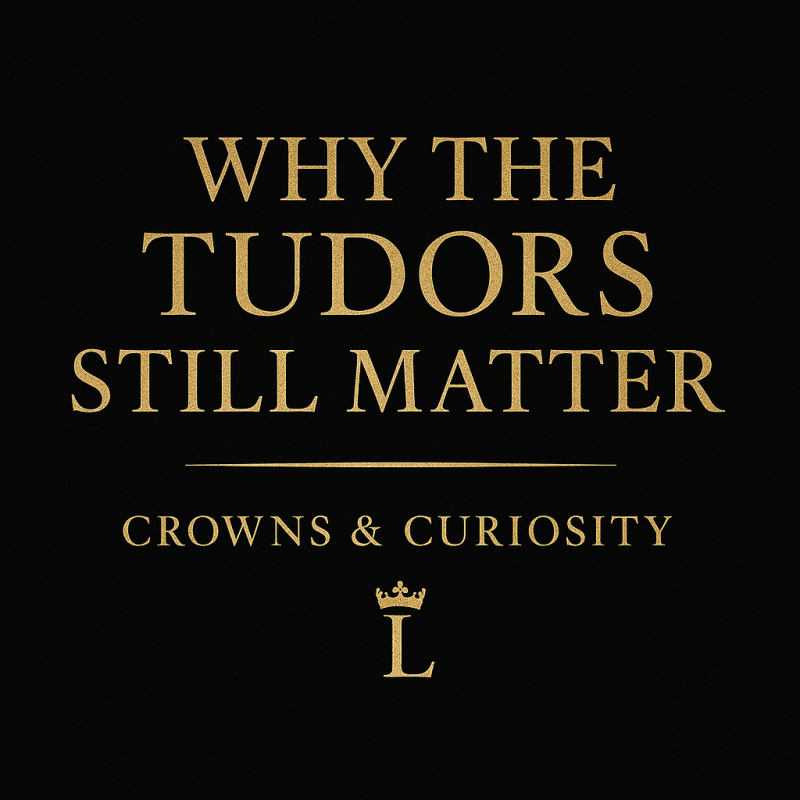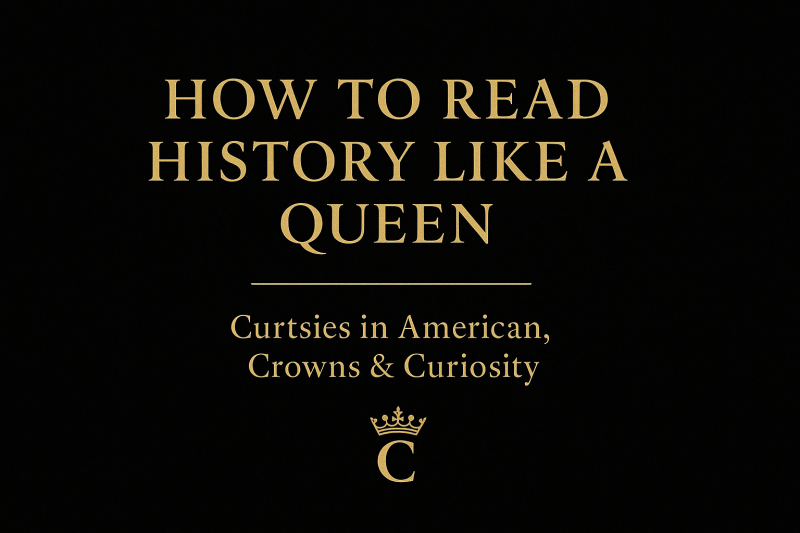My Love Letter To Queen Elizabeth II
"I never have to introduce myself. They all seem to know who I am." - Queen Elizabeth II
Nov 18, 2025 7:20 PM
"I never have to introduce myself. They all seem to know who I am." - Queen Elizabeth II
Nov 18, 2025 7:04 PM
Who are the Tudors?

This is a question I get a lot, and I never know if who is asking means “Why do they matter to you” or “Why do they matter at all anymore?”
The Tudor dynasty is long gone. But there is a reason we keep returning to them.
There is a reason why their faces still grace book covers, why their dramas still spark debate, why their women still inspire fierce loyalty, and their stories feel strangely modern.
It has been 500 years…yet they refuse to fade.
It is because the Tudors were never just a dynasty.
They were a turning point – and a mirror.
Here I will explain and give 7 reasons why they still matter. To both me and at all.
The Tudor period wasn’t simply a chapter in English history; it was a transformation.
Henry VIII’s break from Rome and from the Pope redefined religion, sovereignty, and the very idea of national identity.
Elizabeth I’s reign laid the groundwork for global exploration, cultural renaissance, and political strategy that still influences leadership in all forms today.
What they did didn’t stay in the 16th century. It rippled outward and into our laws, our literature, our language, our politics, and our worldview.
We live in their aftermath.
Anyone that has read about the Tudors knows that their stories are filled with ambition, betrayal, heartbreak, survival, hope, fear, devotion, loyalty, and desire.
These are not distant archetypes; they are people whose emotions are relatable and feel familiar.
A queen fighting for legitimacy.
A king desperate for legacy.
A woman risking everything for love.
A girl destroyed by a world she never stood a chance against.
Who can read about the Tudors and think I know that feeling.
EVERYONE.
We can see recognizable qualities in Henry VIII’s wives:
Katherine of Aragon’s endurance.
Anne Boleyn’s brilliance and danger.
Jane Seymour’s quiet influence.
Anne of Cleves’ strategic grace.
Catherine Howard’s vulnerability.
Catherine Parr’s intelligence and authorship.
And beyond the wives:
Elizabeth I redefined rulership.
Mary I, whose legacy is still misunderstood.
Mary, Queen of Scots, was the tragic force of charisma and grace.
And Margaret Beaufort, who historians widely accepted as the architect of the entire Tudor dynasty.
These women are not footnotes. They are the pulse of the Tudor story. They were powerful, flawed, brilliant, and HUMAN. In them, modern women find reflection.
The Tudors are the most mythologized dynasty in the Western world. Yet every year, new research overturns a past historical assumption.
For example:
Anne Boleyn wasn’t the seductress history labeled her as.
Catherine Howard wasn’t the stupid, silly girl they described.
And my FAVORITE myth that was debunked (don’t forget about this, you will hear more about it later, dear reader): Henry VIII wasn’t simply a tyrant; he was also deeply insecure.
We (I) love them because the truth is always shifting, and it always turns out better than the legend.
The Tudor era served as the crossroads where medieval met modern.
Printing replaced memory.
Learning replaced superstition.
Self-awareness replaced divine fate.
Royal courts became political theatres.
Women gained new (albeit small) forms of influence.
When you are studying the Tudors, you watch the modern world begin to breathe.
TV shows, movies, novels, documentaries, Instagram pages and internet blogs (Hi!) have the Tudors returning constantly.
But why?
I am trying hard not to say it’s because of Jonathan Rhys Meyers. I am sure my generation will, anyway. *
It is because the way we interpret them says more about OUR time than theirs.
I’ll use Anne Boleyn as an example.
When society fears powerful woman, then Anne is seen as a witch.
When society celebrates ambition, Anne becomes a feminist icon.
The Tudors are endlessly adaptable, endlessly relevant, and endlessly revealing. They are like the best movie you have ever seen; even though you know how it ends, it doesn’t mean it isn’t still exciting.
The crown was not just a symbol for the Tudors.
It was a dinner table.
A whispered promise.
A broken heart.
An unanswered letter.
A child lost.
A marriage negotiated.
A betrayal unfolding in the candlelight.
The Tudors remind us that history is not shaped in grand halls, but in human moments.
And that is why we still care about them.
TO WRAP THIS UP
The Tudors still matter because they offer us everything: drama, humanity, transformation, complexity, inspiration, warning, and wonder.
We don’t just read their story; we feel it. We debate it. We argue about it. We learn from it.
We see ourselves inside it.
The Tudors survive because their world is not gone. The dynasty lives on wherever there is power, ambition, love, disaster, brilliance, or courage.
Basically, it lives wherever there are humans.
*Jonathan Rhys Meyers starred in the Showtime series The Tudors from 2007-2010.
::Curtsies in American::

History is not meant to be tiptoed around. It’s meant to be entered — boldly, curiously, and with a crown’s confidence. To read history like a queen is to understand that the past isn’t a distant museum: it’s a living court of voices, choices, flaws, brilliance, and echoes that still shape us now.
I think I have said it before, but I will say it again. I am not a historian. But one is allowed to enjoy studying history on their own (and it doesn't have to be boring!)
Here are my 7 steps to enter into that world with the grace, intelligence, and authority of a queen.
1. Lead with Curiosity, Not Judgment
A queen observes before she speaks.
Instead of asking, “Was she/he right or wrong?” ask:
It is very easy to judge the actions of someone that lived 500 years ago with modern eyes. It is harder (and more interesting) to keep an open mind.
Curiosity opens doors. Judgment closes them.
When you read history with curiosity, people become more than characters — they become human.
2. Know the Power of Perspective
Queens understand that one story is never the whole story.
For every Anne Boleyn, there is a Cromwell.
For every Elizabeth I, there is a Mary, Queen of Scots.
For every powerful king, there is a woman in the shadows shaping the room.
Reading history like a queen means looking for the missing voices — the ones who moved the world quietly, sideways, behind the screen.
3. Look for Patterns, Not Just Events
History is full of cycles, not isolated dramas.
Ask yourself:
Queens recognize patterns — and patterns reveal truths.
4. Read the Footnotes (a Queen Loves Receipts)
A queen doesn’t just accept what she’s told.
She checks the sources.
Every historian has a lens. Every era has its agenda. It is fully acceptable to fall down the rabbit hole of facts.
Footnotes are where you discover who is shaping the story — and why.
It’s not nerdy.
It’s royal.
5. Let Yourself Feel Something
History isn’t dry when you allow emotion into it.
Reading history emotionally doesn’t make you biased —
it makes the story alive.
Queens feel deeply and think sharply.
6. Hold Complexity Like a Crown
A queen knows people can be contradictory.
Henry VIII was cruel and charismatic.
Anne Boleyn was brilliant and abrasive.
Elizabeth I was powerful and painfully alone.
Complexity isn’t confusion.
It’s truth, and it is the human experience.
Reading history like a queen means holding multiple truths at once without dropping any of them.
7. Claim Your Place in the Story
You read history not as an outsider,
but as someone who belongs in the halls of power.
Ask:
A queen doesn’t just study history.
She inherits it.
In the end…
To read history like a queen is to read with:
✨ curiosity
✨ compassion
✨ skepticism
✨ intelligence
✨ imagination
It’s to honor the people who came before —
not by idolizing them,
but by understanding them.
And in that understanding,
you build your own crown.
::Curtsies in American::
Nov 18, 2025 7:20 PM
"I never have to introduce myself. They all seem to know who I am." - Queen Elizabeth II
Nov 18, 2025 7:04 PM
Who are the Tudors?
Add comment
Comments
Thank you for sharing your experiences and your passion for the subject.